
The Tequila splitfin, aka Tequila fish, gets its specific epithet from the Tequila Volcano, which is situated nearby. They are endemic to the Ameca River basin in west-central Mexico. Their current distribution is restricted to a single spring pool in Teuchitlán, only 13 feet in diameter. These fish face the threats of habitat loss and destruction at the hands of farming, ranching, dams, and water management; recreational activities; land pollution & water pollution; and invasive species, that can result in predation. The IUCN lists these fish as Endangered. However, their population is slowly increasing.
First the Stats…
Scientific name: Zoogoneticus tequila
Weight: Up to .10 ounce
Length: Up to 3.15 inches
Lifespan: Up to 5 years
Now on to the Facts!
1.) The singular pool in which these fish are found consists of 80% exotic species, and 50% twospot livebearers.
2.) DNA analysis of natural populations of these fish have proven that because the populations are extremely small, there is a fair amount of inbreeding which could be contributing to the decline in populations in the wild.
3.) The process to recover the Tequila splitfins even further would be to introduce individuals from the wild to the very limited, endemic population of the nearby Santiago River. Since the wild population has been declared extinct nearly 20 years, this opportunity is not possible, unfortunately.
4.) Recent efforts by scientists beginning in 1998 have been able to revive the declining population within the river through breeding the fish in labs. In order to do this, Tequila fishes that were bred by scientists in labs were reintroduced into the river in intervals, with 1,500 fish being released into the river in total.
5.) Freshwater fish in particular face a large threat of extinction due to the significantly higher rate of endemic species in these regions.
But wait, there’s more on the Tequila splitfin!
6.) Amphipods, insects, ostracods (also known as seed shrimp), and detritus make up their diet.
7.) Females give birth to up to 29 live young. This makes them, what are called, in the ichthyology (study of fish) field, livebearers.
Did you know…?
There were only an estimated 80 individuals remaining at 1 time. That’s how close they came to extinction.
8.) Just like many other livebearer fish, the fry are left to fend for themselves, with no parental care provided by the mother. That being said, most of the fry are eaten.
9.) After reintroduction efforts that went on for 7 years, their population is recovering and is now beginning to flourish in their endemic location.
10.) The Ameca River Basin is home to many endemic species that fall within this family of fish, but like the Tequila splitfins, most remain outnumbered by introduced species like the guppy.
Now a Short Tequila Splitfin Video!
Be sure to share & comment below! Also, check out the Critter Science YouTube channel. Videos added regularly!

Want to suggest a critter for me to write about? Let me know here.
Some source material acquired from: Wikipedia & IUCN
Photo credit: Loury Cédric



